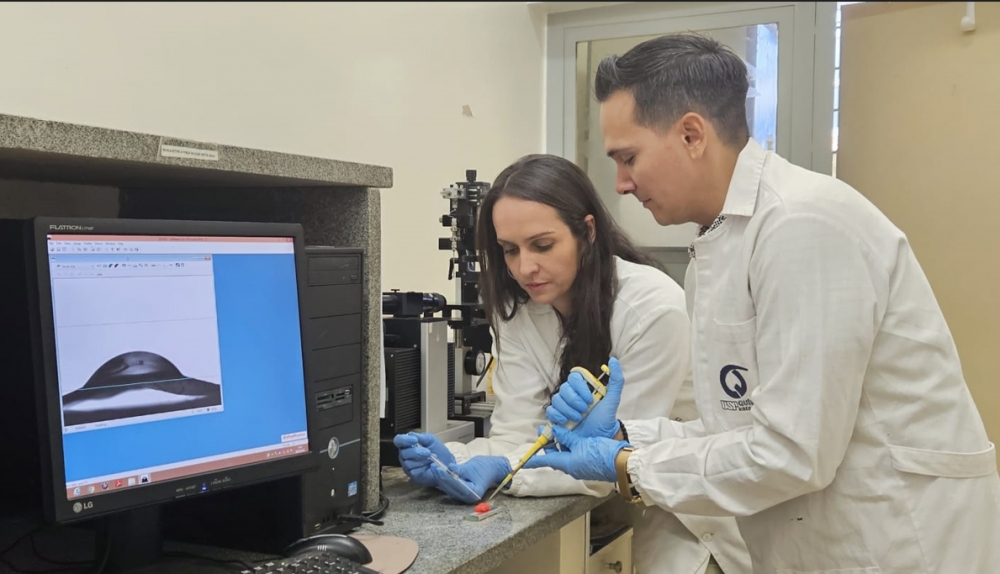

Photo: researchers’ archive
Researchers at the University of São Paulo conducted in vitro experiments with bone cells to confirm the properties of the novel biomaterial. Their findings suggest it can replace natural bone in grafting procedures to remedy defects or injuries.
Researchers at the University of São Paulo conducted in vitro experiments with bone cells to confirm the properties of the novel biomaterial. Their findings suggest it can replace natural bone in grafting procedures to remedy defects or injuries.

Photo: researchers’ archive
By Julia Moióli | Agência FAPESP – A study conducted at the University of São Paulo (USP) in Brazil showed that a novel biomaterial made of collagen and carrageenan, a polysaccharide extracted from red seaweed (Rhodophyta), stimulated the process of bone mineralization in vitro (in the laboratory), suggesting that it has the potential to replace natural bone in grafting procedures used to treat severe injuries or diseases such as osteosarcoma.
The biomaterial, described in an article published in the journal Biomacromolecules, was developed by researchers affiliated with the Colloid and Surface Physical Chemistry Laboratory at the university’s Ribeirão Preto School of Philosophy, Sciences and Letters (FFCLRP-USP). Their work has long been supported by FAPESP (projects 19/25054-2, 18/25871-8 and 22/01219-5).
Autogenous bone grafting, which entails taking bone tissue from one part of the body and transplanting it to another part, is considered the gold standard for bone regeneration and augmentation. There are challenges, however, such as the need for an additional surgical procedure, risking infection, and the difficulty of performing grafts in large areas.
Artificial materials that mimic bone structure and can be used safely in grafting procedures are therefore at a premium. The novel biomaterial in question is a compound of bovine or porcine type I collagen, the most abundant protein in bone, and carrageenan, similar to the chondroitin sulfate that mineralizes natural bone and promotes cell adhesion.
To test its viability and potential, the scientists grew osteoblasts in the laboratory using only collagen and using a combination of collagen and carrageenan. Osteoblasts are the cells responsible for bone synthesis and mineralization.
Microscope images of the surface of the osteoblasts cultured with the collagen-carrageenan combination showed the presence of a dense and uniform network of intertwined fibrils, while lateral images showed the presence of collagen fibrils with parallel alignment, which is characteristic of dense connective tissue.
The researchers also observed an increase in expression of key genes that encode proteins relating to bone mineralization, such as alkaline phosphatase (Alp), bone sialoprotein (Bsp), osteocalcin (Oc) and osteopontin (Opn).
“Our results show that the combination of collagen and carrageenan stimulated the cells’ mineralizing response better than collagen alone, validating in vitro the hypothesis that the presence of a component chemically and structurally similar to one of the compounds found in bones together with collagen is fundamental to the process,” said Ana Paula Ramos, co-principal investigator for the study and a professor in the Department of Chemistry at FFCLRP-USP. “Our next step will be to conduct in vivo tests to evaluate the possibility and safety of treating any bone defect with this biomaterial.”
Carrageenan is widely used by the food and cosmetics industries as a stabilizer. According to Ramos, its advantages include abundance, low cost (in contrast with the high commercial cost of chondroitin sulfate), and the fact that it comes from a renewable source, guaranteeing its compatibility with the concept of green chemistry, which aims to reduce the use of substances that cause pollution or otherwise harm the environment.
Knowledge of several areas
“In addition to developing a biomaterial for use in bone grafts, we have paved the way for further basic research by creating a biomimetic matrix from scratch and blending it with natural tissue,” said Lucas Fabrício Bahia Nogueira, first author of the article and a researcher in the Department of Chemistry at FFCLRP-USP.
“This will enable researchers in different areas to understand and observe how these cells interact with the microenvironment and the mechanisms of mineralized tissue formation so that they can apply this knowledge to studies of mineralization in other contexts, such as cardiovascular and kidney diseases.”
The study was interdisciplinary and involved collaboration with FFCLRP-USP’s Applied Nanotechnology Laboratory, headed by Professor Pietro Ciancaglini.
The article "Collagen/κ-carrageenan-based scaffolds as biomimetic constructs for in vitro bone mineralization studies” is at: pubs.acs.org/doi/10.1021/acs.biomac.2c01313.
Republish
The Agency FAPESP licenses news via Creative Commons (CC-BY-NC-ND) so that they can be republished free of charge and in a simple way by other digital or printed vehicles. Agência FAPESP must be credited as the source of the content being republished and the name of the reporter (if any) must be attributed. Using the HMTL button below allows compliance with these rules, detailed in Digital Republishing Policy FAPESP.





